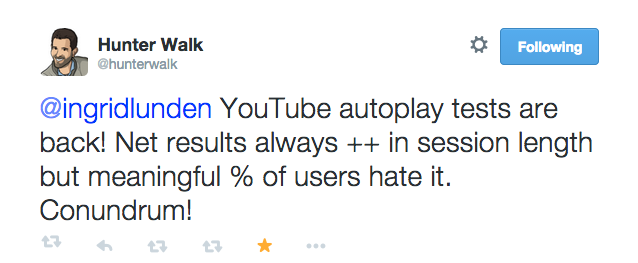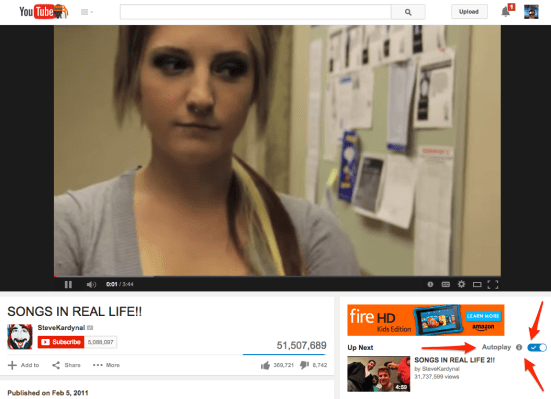YouTube, always on the lookout for ways to keep people watching more videos and staying on its site longer, is testing out a new feature that could prove to be a honeypot (or major annoyance!) for casual visitors: video autoplays, where once the video you came to watch ends, instead of defaulting to the usual grid of suggested videos, another video starts up.
The feature was flagged to us by Deepanker Verma, whose Indian blog Techlomedia wrote up the appearance of the Autoplay function.
We reached out to YouTube to find out more. A spokesperson confirms to us that autoplay been rolled out globally with a “small percent” of users to the site while it collects feedback on the feature. (In fact, the illustration here comes from an avid YouTube user who lives in Fresno who is also in the test group.)
“With more videos coming to YouTube every minute we’re always experimenting with ways to help people more easily find, watch and share the videos that matter most to them,” said the spokesperson. “We’ll consider rolling features out more broadly based on feedback on these experiments.”
 As you can see in the screenshot above, Google/YouTube currently presents autoplay as an optional feature. It’s set to “on” by default every time you open a new video, at which point you get an “up next” dialogue on the screen before the next video plays.
As you can see in the screenshot above, Google/YouTube currently presents autoplay as an optional feature. It’s set to “on” by default every time you open a new video, at which point you get an “up next” dialogue on the screen before the next video plays.
Those who prefer not to see the suggested stream can disable it — although it seems you have to do this each time you open a new video.
Clarification: YouTube tells me that the autoplay toggle on the top right of the page is permanent: once you turn it off, it will stay off. You’ll only see the countdown screen when autoplay is ‘on’, and the ‘cancel’ button on that screen turns off the autonav just for that video.
Autoplay: more like traditional TV
There are a few good reasons why it makes sense for YouTube to push a feature like auotplay more widely.
As we have seen with other streaming sites, one of the biggest problems with a large selection of content is being spoiled for choice: you can watch anything you want, but you don’t know what you actually want to watch.
YouTube — like Spotify and Netflix — have been trying to come up with different ways of tackling that problem, including integrating social features so that you can see what your friends are watching; creating playlists; and using playlists made by others. You can think of autoplay as a complement to those for casual users who are less social or less organised, or looking for an even more lean-back experience.
In that sense, it is a format that feels a lot like the site’s namesake: the tube, or broadcast television, where you are dealt a stream of video content on channels without much interaction.
Currently users spend on average 24.4 minutes on YouTube per visit, according to comScore — a number very close to the classic half hour of a TV program.
Right now it looks like the other videos that appear in the autoplay stream are just others from the YouTube catalog, but you can see how the format would lend itself to another piece of video content that YouTube already automatically inserts elsewhere: advertisements.
With video ads being a hot commodity these days, having a place where YouTube could insert an ad after a video as well as before the video effectively could double its inventory.
Interestingly, after Susan Wojcicki was appointed head of YouTube earlier this year, it came with a new focus on revenue generation and advertising, specifically looking for ways to inject more advertising and advertiser-friendly formats into YouTube. “Advertisers have said they want YouTube to resemble a TV network,” one writer pointed out. Autoplay would help with that.
It could also potentially be a boost in competition with Facebook for eyeballs and ad dollars. Facebook is passing YouTube for video views by some estimates, in part because of its own version of the autoplay feature — where videos begin to play when you scroll past them in your timeline (albeit on mute).
But as with so many changes on YouTube, despite the positives for the bottom line, it could also become really annoying. We could find tests of the feature once before, back in August 2014, when the autoplay feature was ID’d by Google system enthusiasts, who figured a way to call it up by modifying YouTube’s cookies.
But one ex-YouTuber alludes to it as something that Google has toyed with even earlier. While autoplay was effective in getting people to stay on the site for longer, a “meaningful percentage” of users hated it.

Indeed, many others responding to this story on social media and in the comments below have pointed out how this would be irritating, with one singling out YouTube power users specifically.
Along, with autoplay, YouTube has been working on other features in limited rollouts, such as a GIF creator and offline viewing.
Updated with extra commentary.
